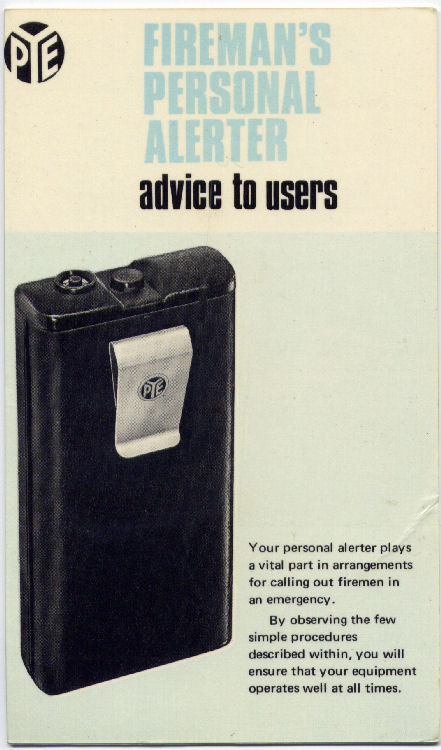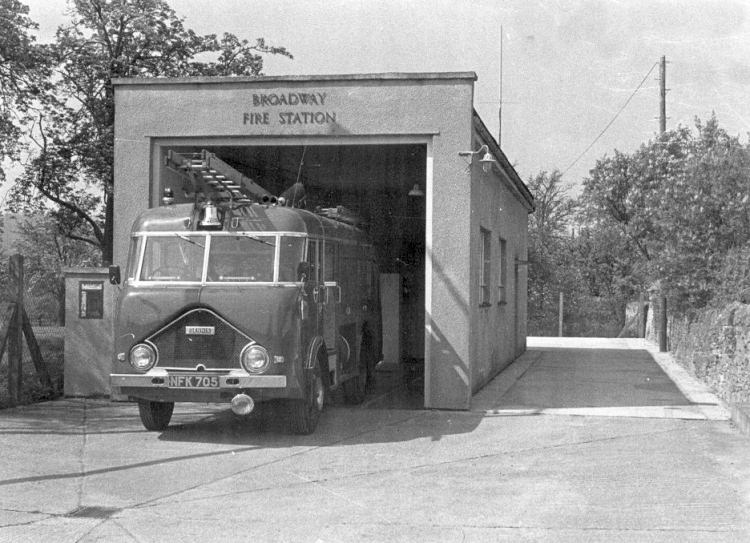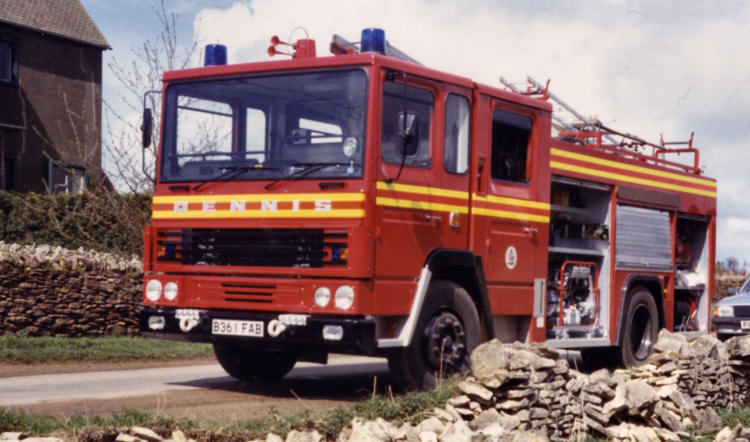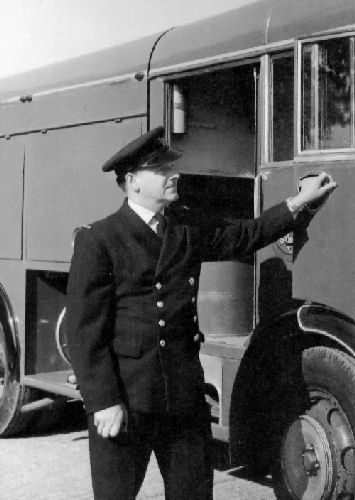| Home . Formation . Equipment . Funding . Local Agreements . Captains . 1897-1933 . Joint Brigade . WW2 . Post War . 1950s . Fires . Gallery | |||||||||||||||
|
The
1950s to Modern Times
|
|||||||||||||||
| Callout Systems | |||||||||||||||
| The Broadway brigade had never had a very effective system for calling out the crew. In the early days there was a hand operated bell on the roof of the fire station which was, later, replaced by a small siren on the police station. Neither system proved to be very effective. | |||||||||||||||
|
|||||||||||||||
|
A
few years later equipment was introduced to allow the siren and bells
at Broadway to be controlled remotely from the continuously manned watch-room
at Evesham fire station. Despite the problems with this system, for
the first time, the village's brigade had a successful method of calling
out the crew in the event of fire. Not until April 1968 was equipment
installed which enabled the siren and house bells at Broadway to be
operated directly from the fire control room at Worcester.
|
|||||||||||||||
|
|||||||||||||||
|
|
|||||||||||||||
|
Radio
As early as 1951 the Worcester City & County brigade had two way wireless sets installed in a few vehicles, and in their control room. But radio equipment was not fitted to the Broadway appliance until 1966. At first the brigade used the same frequency as the Worcestershire police, so when calling the control room the mobile would ask for ‘YKA’, (the police being ‘YK’). The Broadway water tender’s call sign was ‘48’ up until 1974 when it changed to '303' ('three zero' denoted the station number, and 'three' identified the appliance as a water tender). Wireless communication provided another great advance in the efficiency of the fire brigade. When at an incident it was no longer necessary to find a telephone in order to send information to Brigade Control and, more importantly, assistance could be ordered without delay. |
|||||||||||||||
|
|
|||||||||||||||
|
Training
Ever since the formation of the Broadway fire brigade in the 19th Century, lack of training had been seen as a problem. Drills and practices were only held on rare occasions. The Parish Council’s recommendation, in 1919, that three practices should be held each year, gives some idea of the poor standard of training in the early days. Soon after the Second World War the principle of weekly, two hour, practice sessions for retained crews was firmly established nationally. Initially, at Broadway, these were held every Sunday morning from 10.00 until 12.00. The crew used the time to maintain and test the equipment. Occasionally they would travel to Evesham fire station to listen to lectures. Nationally, competitions and exercises were organised to encourage stations to improve their training standards. The Broadway crew attended many of these. Most notable of which was "Exercise Grand Slam", which was held on Sunday 2nd November 1952 near Oldbury. The object was to simulate atomic warfare conditions, and all available appliances and personnel took part in an exercise which lasted nine hours. |
|||||||||||||||
|
|||||||||||||||
|
Attempts
by the Brigade to provide a drill tower for Broadway fire station have
been viewed unfavourably. The idea has been opposed by the Parish Council,
with aesthetics apparently being deemed, by some, more important than
a proper training facility.
To check the crew's speed of response to fire calls they were, in the 1950s, ‘60s and early ‘70s, subjected to a test turnout every few months. A senior officer would attend the fire station, often around midnight, and order the control staff to operate the siren and bells. Using a stop watch he would then note the time it took for the crew to attend the station, and to drive the fire engine on to the forecourt with the crew on-board. Even at night, times as short as 3 minutes 30 seconds were not unusual. Test turnouts were discontinued in 1973 as, presumably, the better monitoring of turnout times by Fire Control would have shown up any problems. |
|||||||||||||||
|
|
|||||||||||||||
|
|||||||||||||||
|
This
area was enlarged, later, on the recreation ground side of the station,
to provide more parking. A toilet, washing area and shower were added
in the late 1970s. Prior to this the crew used the public toilet facilities
in the nearby recreation ground. Although, obviously, an improvement
on the original 1898 fire station, the new building has never been considered
suitable, and is now well overdue for replacement.
|
|||||||||||||||
|
|
|||||||||||||||
|
Fire
Appliances
In 1939 the Broadway brigade had been supplied by the Home Office with a trailer pump, which remained in service after the war. The pump carried no water but was either supplied from a hydrant or drew water from any nearby pond or stream. It was hauled to fires, as stated earlier, by Steward’s builders lorry until sometime in the late 1940s or early 1950s. At that time the fire station was enlarged to accommodate the auxiliary towing vehicle (ATV) assigned to Broadway. The auxiliary towing vehicles had been built during the Second World War, to Home Office specifications, to haul the huge number of trailer pumps supplied to fire brigades at that time. It had been expected that private vehicles would be pressed into service to haul the pumps, but when this proved not to be the case the Home Office ordered the construction of a fleet of towing vehicles. They were built on the Austin K2 chassis with a six cylinder, twenty-four horse power engine. A ladder was carried on the roof of the van body. There were lockers inside where equipment was stored, and benches to seat the crew. A canvas sheet closed the back in bad weather. Some of the ATVs, including Broadway’s, were later fitted with a one-hundred gallon water tank, pump and a hose reel. This made it possible to get water on to a fire immediately, without having to connect into a hydrant. The hose reel jet is, to this day, the quickest and most effective way of fighting most smaller fires. |
|||||||||||||||
|
|||||||||||||||
|
and
represented the very best of fire appliance design. This appliance,
having covered only thirteen thousand miles, and in excellent mechanical
order, was replaced in 1998 with one which was built two years later
but with over fifty thousand miles on the clock. This was in line with
the brigade’s then current policy of automatically replacing appliances
when they reach a certain age.
|
|||||||||||||||
|
|
|||||||||||||||
|
Officers
in Charge
At some time during the Second World War the officer in charge of the Broadway brigade became known as Leading Fireman instead of Captain. The change probably came about with the formation of the National Fire Service in 1941. When the Broadway brigade became part of the Worcester City & County Brigade in 1948 its Leading Fireman was Frank Turner, whose full time job was at Gordon Russell's furniture factory. |
|||||||||||||||
|
|||||||||||||||
|
Roy
was determined to remedy this situation. He had no success through the
usual channels, so during a social gathering at Evesham fire station
one Saturday evening he put his case, forcefully, to the Brigade's Chief
Fire Officer, Mr Doyle. Within a few days the Dennis had been replaced
with much more modern appliance.
When Roy left the Brigade around 1990 his place as officer in charge was taken by Frank Trowman. Frank followed Roy's example, and maintained high standards at the station. After about eight years in the post, and twenty-six years as a fire-fighter, Frank decided to leave the brigade in order to take life easier. Sadly, only two years later in February 2000, he lost his life in a motorcycle accident on Fish Hill. |
|||||||||||||||
|
|
|||||||||||||||
|
Equipment
The standard of fire appliances and equipment supplied to Broadway’s fire fighters, as with the rest of the Brigade and, indeed, nationally, continued to improve through the 1970s, 80s and 90s. Much greater emphasis was placed on the personal safety of the fire-fighter, and on training the crew to use the ever more complex equipment. Up until the early 1970s the only protection, available to the Broadway crew, against smoke inhalation were Second World War gas masks. It was quite normal for crews to work for hours whilst breathing-in smoke. It would now be unthinkable for a fire-fighter to enter a burning building, or any other smoky atmosphere, without breathing apparatus. As stated earlier, victims of road traffic accidents were extricated using crowbars, hacksaws, cold chisels and lump hammers, where now, every front line appliance carries hydraulic cutting and jacking gear. Communications have been revolutionised by the introduction of portable radios and an on-board computer. Modern fire appliances carry a huge array of lighting equipment; everything from hand held torches to halogen lamps powered by 110volt generators. Foam for fighting oil fires is carried on most pumps, and can be generated quickly when required. Water remains the main medium for extinguishing fires, but pumps hose and branches have been greatly refined and improved over the years. |
|||||||||||||||
|
*My
comment regarding the absence of women serving in the Broadway Brigade
was true when this history was written in the 1990s. However, it's pleasing
to note that a number of female fire fighters have joined the ranks
at Broadway since 2003.
Also, throughout this history I make reference to 'Fireman' or 'Firemen', rather than the now universal term, 'Fire-fighter'. The more modern expression acknowledges, correctly, that fire-fighters are of either gender. I have simply used the term which was current during the era I happen to be discussing, and do not intend any disrespect to modern day crew members. Similarly, since this history was written, other terms have changed. For example, the acronym 'RTA' (Road Traffic Accident) has been superseded by 'RTC', but I believe it is not always helpful to continually edit in order keep pace with changing labels. |
|||||||||||||||
|
|
|||||||||||||||





